Moss creates a stunning visual effect in any indoor space, so it’s no surprise that you want to create an indoor moss garden of your own.
Fortunately, this isn’t tough to accomplish! In this guide, I’ll give you the ins and outs of growing moss indoors, including how to care for your moss garden once you have it set up.
Growing moss indoors is a relatively simple project. All you need to do is -
- Gather a little bit of moss from nearly anywhere
- Create an environment that will allow that moss to grow and flourish.
This is done using a glass or plastic container, like a terrarium or mason jar, and different natural materials to mimic the great outdoors.
Mist a bit of water every now and then, ensure your moss has exposure to plenty of sunlight, and avoid using fertilizer to help your moss garden grow.
While growing moss indoors is quite simple, there are some details to moss growth and care that you need to keep in mind. You will need specific items and tools to properly gather, transplant, and care for your moss.
Below, I will go into great detail to teach you how to get the most out of your new indoor moss garden.
A Comprehensive Guide to Growing Moss Indoors
Moss is incredibly easy to grow, but you need to know what moss needs to thrive in order to grow it indoors successfully.
Moss flourishes in areas with adequate moisture and plenty of sunlight, so you should focus on re-creating the natural circumstances in which moss grows.
A Shopping List for Your Indoor Moss Garden
First things first, you need to gather the right materials. Unlike planting other forms of flora, you do not need to use fertilizer or nutrient solutions. Here’s what you need to have on hand, with examples featured from Amazon.
Pincers
These are used to gather and arrange your moss, as well as help you to gently remove any dead material from your indoor moss garden. These basic tweezers are perfect for getting the job done.
A container

Plastic works fine, but glass containers are really the most aesthetically pleasing.
There is no particular shape or type of container required here. You can even repurpose an old pickle jar if you want to! I, however, am a fan of the way a geometric terrarium looks, such as this one.
Pebbles
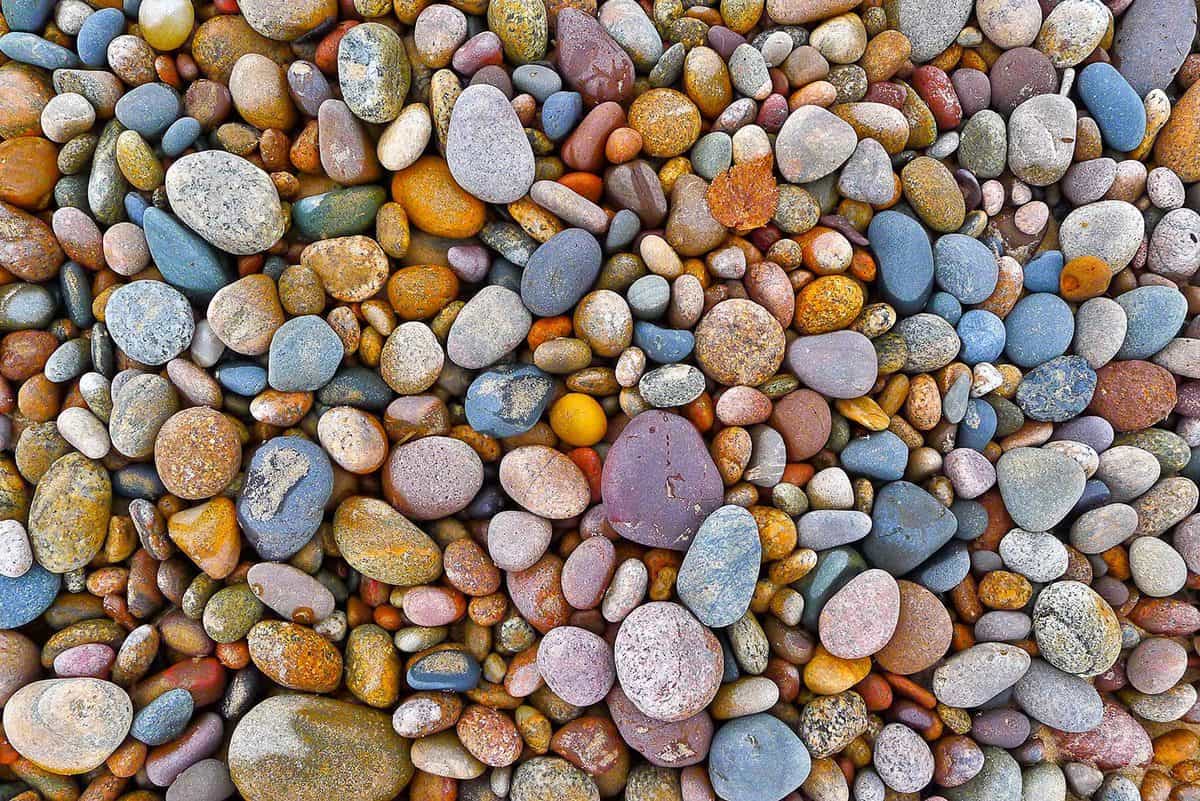
You only need a single layer of pebbles across the bottom of your container to create a base for your indoor moss garden. You can search for pebbles in your backyard or buy them from a landscaping store or Amazon.
Pine needles, rotting bark, or potting soil
Most moss species are best nurtured by either pine needles or rotten tree bark as opposed to potting soil. You may need potting soil if your preferred species of moss requires it.
You only need to build up a single layer of these materials on top of the pebbles to help your moss develop.
A spray bottle
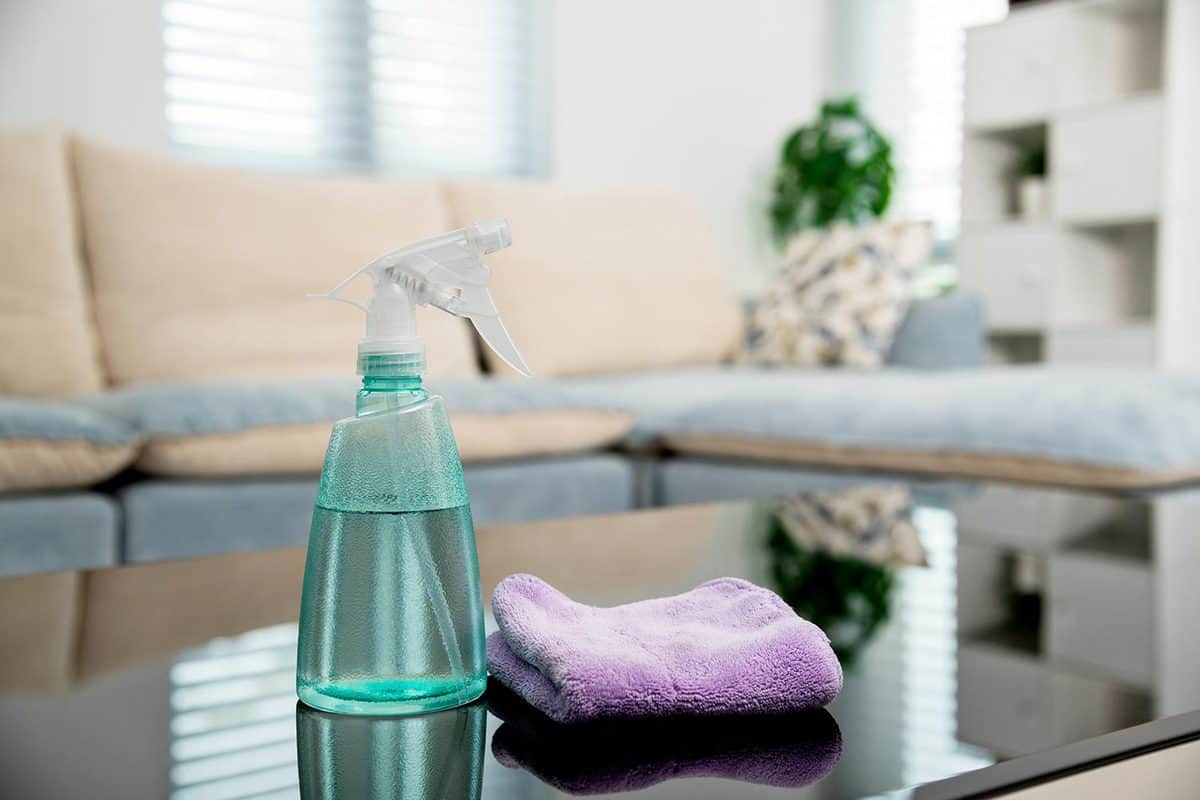
You will need to make sure that your moss is adequately hydrated, and that the interior of your container sustains a humid atmosphere. Use clean, fresh water to hydrate your moss garden as needed. You can buy a special sprayer like this one.
Now that you have all of the above, it’s time to get the moss that will serve as the beginning of your indoor moss garden. You can easily get your hands on some moss if you know where you can find it in your area.
If you’re going to obtain moss from somewhere other than your own property, make sure to get permission first.
Whole sheets of fresh moss are preferred, but if you can only get the moss in sections, that’s fine too. It will all grow the same.
Constructing Your Indoor Moss Garden
Building your contained moss garden is easy once you have everything you need to get started. After collecting your moss and gathering or buying your materials, follow these simple steps:
- Make sure that the container is clean.
- Place a layer of pebbles at the bottom of the container.
- Lay down your rotting bark, pine needles, or potting soil in a thin layer on top of the pebbles.
- Gently place your gathered moss on top of the soil/bark/pine layer.
- Mist the moss with your spray bottle and seal the container’s lid. Watch your indoor moss garden grow!
Indoor Moss Garden Examples
Are you in need of inspiration to design your indoor moss garden? You might be amazed at what you can accomplish with moss!
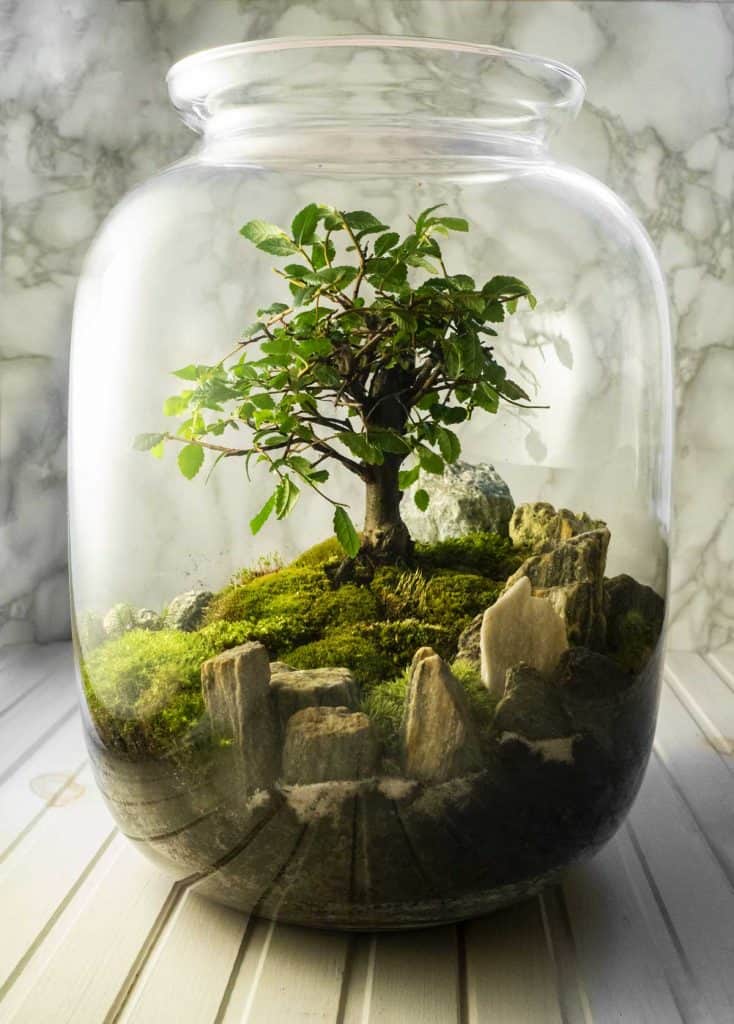
This cute, little moss garden can add a pretty distinct touch to any surface. Its small size makes it easy to care for, especially since you can conveniently place it right on your desk!
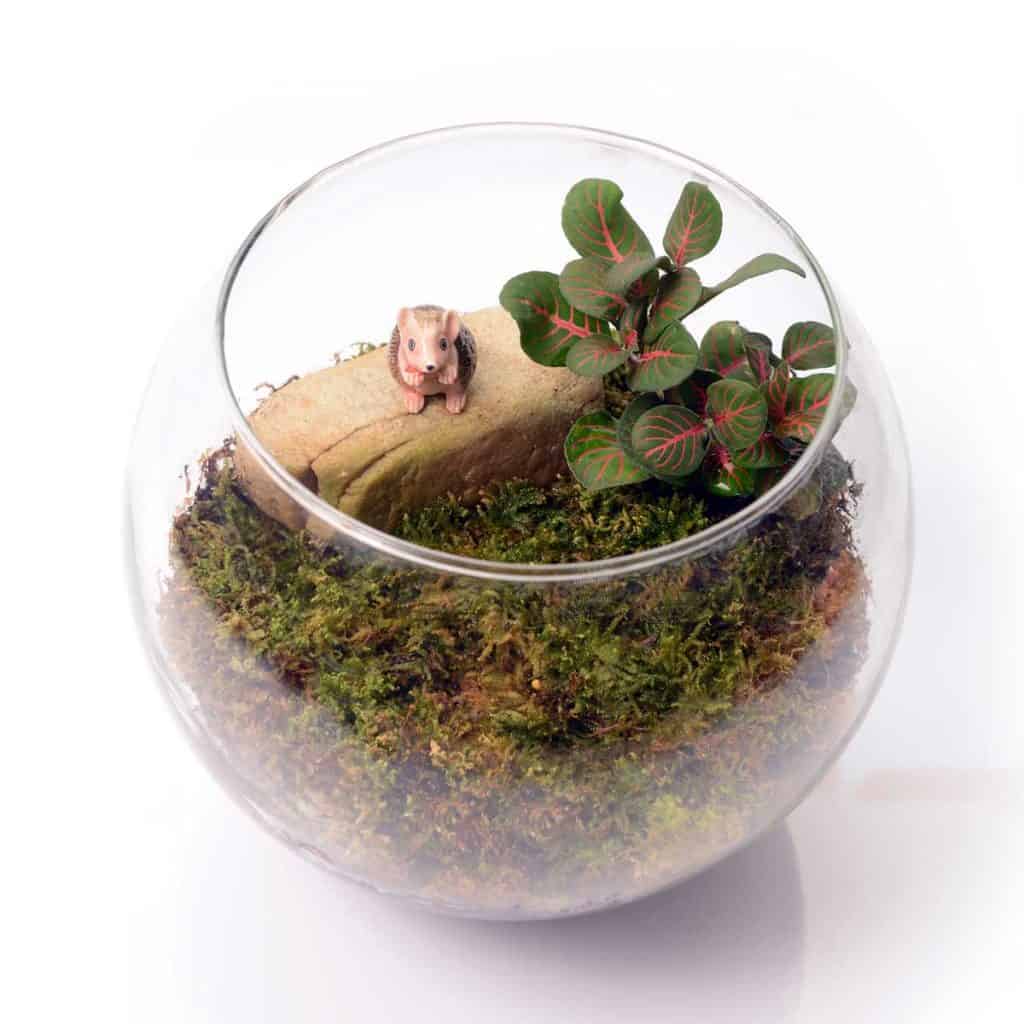
Moss can also be used to enhance the appearance of your existing indoor plants.
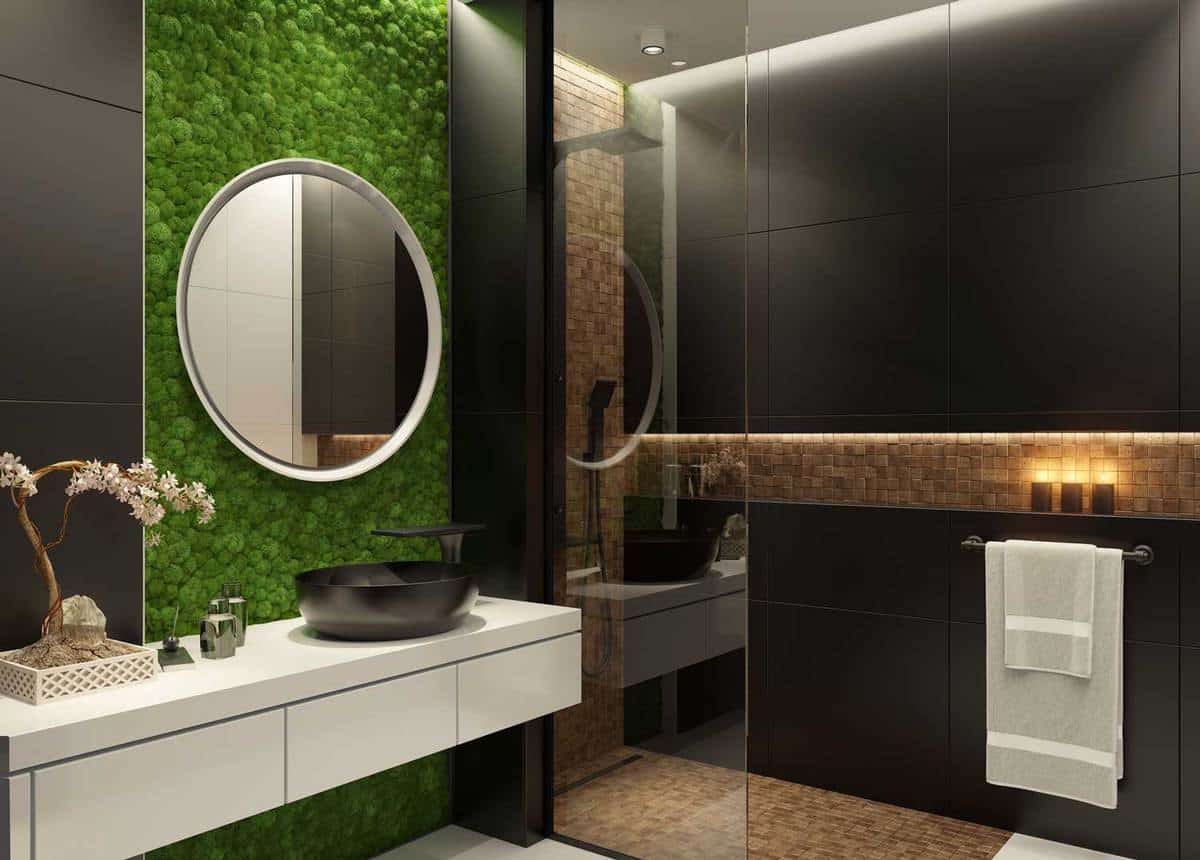
Do you have a green thumb and a lot of patience? It’s possible to grow moss directly on surfaces like walls. I recommend that you get the hang of growing and nurturing moss in a container first, before pursuing an epic undertaking like this one.
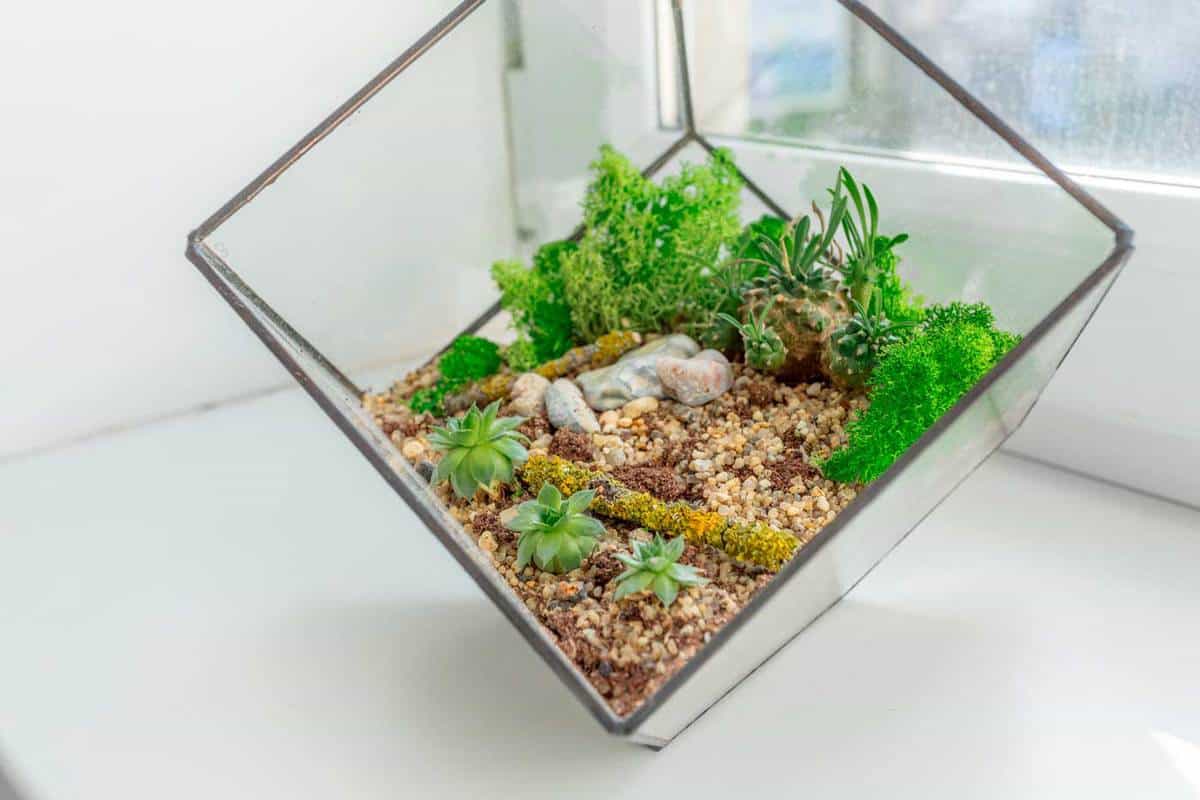
Container gardens are becoming incredibly popular, especially in urban areas. Moss containers add a luscious and unconventional touch that draws the eye and increases the aesthetic of the container garden overall.
Caring for Your Indoor Moss
One great thing about moss is that it requires very little care in order to thrive, even indoors.
In terms of water consumption, however, moss is a fair bit more demanding of water than other types of plants that you may have kept indoors previously. Without adequate hydration and humidity, your moss garden will turn brown and eventually die.
Sunlight
Many people have made the mistake of putting their moss containers in a dark area, in hopes of increasing the humidity within the container. Do not do this! Your moss needs plenty of sunlight, both direct and indirect, to continue developing and growing.
If possible in your current setup, consider placing your container on a windowsill that gets at least a couple of hours of direct sunlight each day.
If this isn’t possible for you, make sure to move your container into an area that does have direct sunlight for at least two hours a day. After that, you can move it to a spot with indirect or less sunlight. This should sustain the moss’ needs.
Alternatively, it is possible to use a fluorescent lamp if you plan to grow your moss in a desktop or tabletop container. Here’s an example of such a setup:
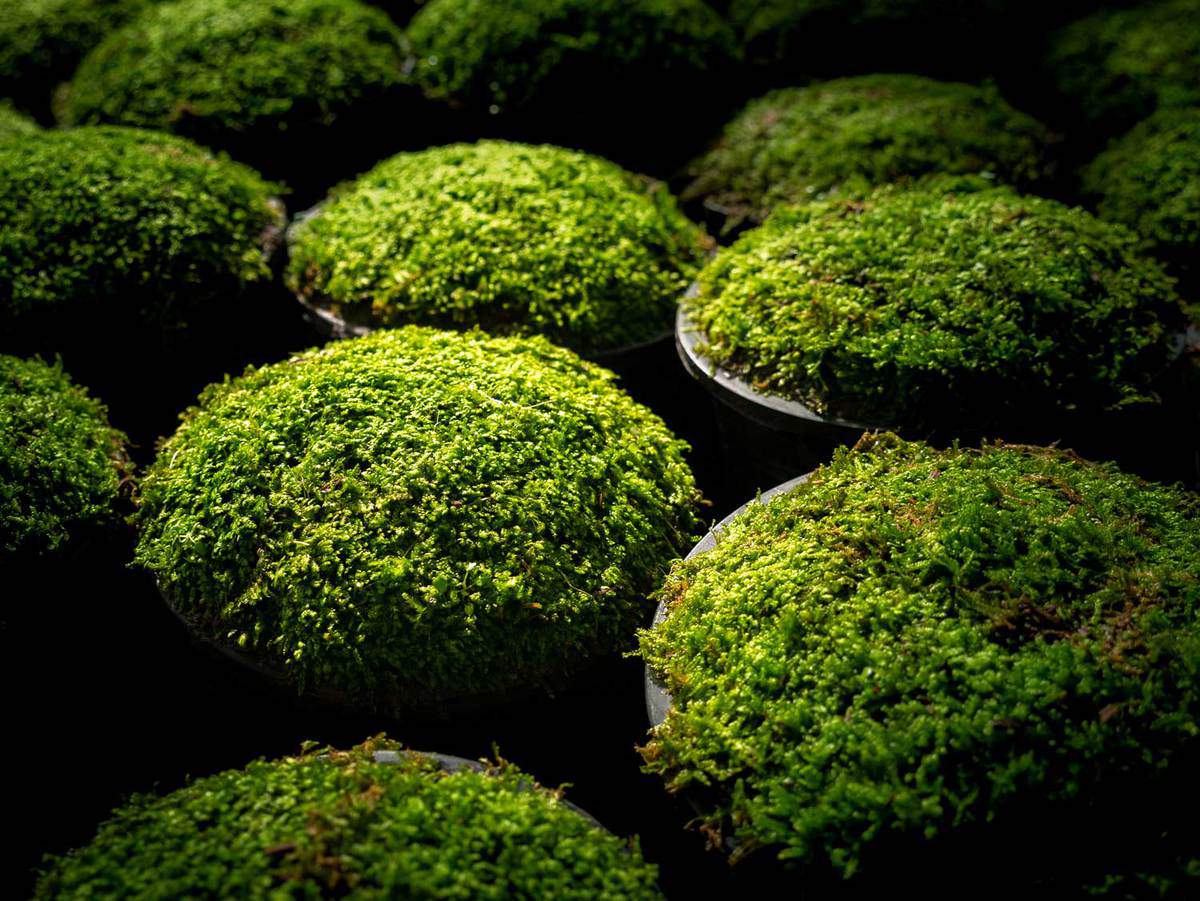
Water
Moss may not need fertilizers or added nutrients, but it does require attentive hydration to continue developing. Moss has no root system with which to take in water, so all of its hydration needs come from the environment surrounding it.
How often you need to mist your moss with your handy spray bottle will depend on a lot of environmental factors and the species of moss itself.
As a rule of thumb, you should water your moss whenever it becomes dry to the touch or loses some of its rich, green colors. Examine your moss daily to ensure that it is damp to the touch and has a consistent shade of its characteristic green throughout the surface.
It is possible to over-water your moss. Avoid creating a puddle or swamp-like atmosphere within the container. If you do make this mistake, the excess water won’t evaporate as it should.
Growing Moss Indoors FAQ
If you have any additional questions surrounding the creation or care of an indoor moss garden, continue to read a brief list of frequently asked questions.
How long can moss live, when indoors?
With diligent watering and attention paid to moss’ needs for sunlight, your moss creations can live and continue growing for months, even years.
How long does it take for moss to grow?
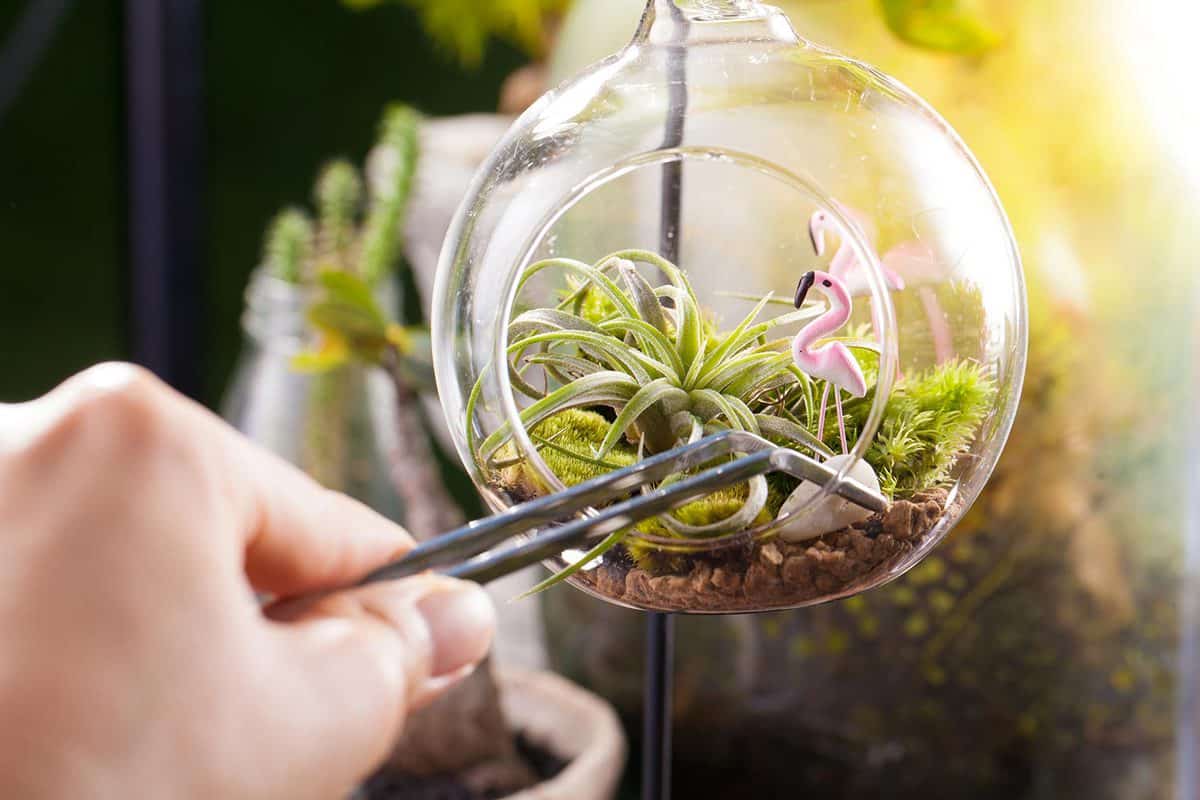
When you ensure that the moss is adequately hydrated and receives plenty of sunlight, you can expect to see some pretty rapid growth after roughly week six.
If you’re creating a small container moss garden, you might notice growth even earlier simply due to the size of the moss garden.
Does moss ever need pruning?
Just like any other type of plant that you may grow, there are going to be some parts of your moss that look great and others that detract from the aesthetic.
You should trim down excessively long pieces of moss that develop over time. This helps to encourage a more full-bodied regrowth.
What do I do if I see mold?
If you’re growing moss in a terrarium or other type of container, mold growth is a very real possibility. This usually happens as a result of over-watering the moss.
Don’t distress if you see white spots (mold) showing up on the surface of your moss plant. Try to wipe it away first. If it can’t simply be wiped away, you can use scissors to remove the mold.
If mold has taken over a significant portion of your indoor moss garden, however, you might be better off simply replacing that moss with newly acquired moss.
How can I prevent mold growth?
Even if you don’t over-water your moss, mold can still form inside your enclosed container. To minimize the risk of this happening, remove the lid to let excess moisture escape from the container. Leave the lid off for a couple of hours once a week or so.
Moss is Beautiful, Versatile, and Easily Maintained
One of the most appealing aspects of moss, aside from its appearance, is how easily it can be maintained even when indoors.
It’s so easy that even children or the busiest of professionals can do it! All it takes is an enclosed container, plenty of sunlight, pebbles and other materials to form a base, and regular misting with a spray bottle to help your moss to thrive.
Moss can be utilized in any number of ways. What you do with it is only limited by your imagination!
Is this helpful? Use the Pinterest-ready image below to add this to your boards.
![How To Grow Moss Indoors [Quick Guide For Beginners]](https://gardentabs.com/wp-content/uploads/2024/04/GardenTabs-Fancy-Pin-Template-1.png)






Hi. I just came across this article. It is much better than some other ones I have read. We did moss for my son’s science project. I have a question about growing moss on a rock. We did the buttermilk slurry technique. And though the other tutorial didn’t say, is it normal for it to be very dry? and also, why would some articles say no sunlight for moss? We had ours in a more shaded part of the house. Thers some light but mostly just because the room lights up when the sun comes out.
Hi Ashley. We’re so glad you found our guide helpful! Once moss is established, it is fairly drought-tolerant, so the dry moss you mentioned shouldn’t be a cause for concern. However, be sure to continue watering it. In terms of shade vs. sunlight, moss does need some sunlight. The notion that moss needs no sunlight at all isn’t accurate. Placing the moss rock on a windowsill where it will get some sunlight throughout the day should suffice. Hope this helps!
Thankyou so much .. I love growing moss and I just loved reading this one ..thankyou for sharing heartfully.
Hello, great read. I’m making some living art with moss and other plants and want to make sure I have good care information to pass on. For moss to live years indoors does it need to get a freezing period? As it would naturally get if outdoors?
I love how moss looks on rocks, this is a truly helpful and inspirational article.
One thing I’m confused about is that most of the photos depict moss in containers that are not enclosed with a lid, nor do they look like they could be— like the moss growing on a wall or in a picture frame. The text explains that the container should be sealed closed except for when watering or maintaining the plant. Sort of misleading I think…… thanks.
Can you tell me what kind of small tree is in the photo?
@Trinnie, I was wondering the same thing.
I have problems with the water I use .
@Clara, use distilled or spring water, moss likes about a 6.0 ph, I always check my water I buy Wally world distilled water. Short for wal-mart – great value distilled water ph is pretty alkaline usually have to lower the ph close to 6.0+ works for me, use it also on my Venus fly traps, bog living. Hope this helps, to many chemicals in city water.
@Clara, I had the same problem when I first started making closed terrariums and most articles-including this one- fail to mention you have to use distilled water
@Jess Ross, ooh ok that what i was doing wring
I just got done hunting and i found some beautiful moss and i decided to start a moss garden and i did not know what to do so i reached and i found this thank you so much for your beautiful website i was so helpful i cant wait to see what happens!!!!
Hi, I love your article and all the tips that you provide because they are very clear. I was trying to make my moss terrarium, I recollected the moss from some plants that I have and it was super green but, when I made the terrarium just a few weeks later turned in brownish. I don’t know if it’s normal or if I did something wrong. I appreciate some advice, thank you.
It could be mold growth. Please go back to this part of the article: How can I prevent mold growth?